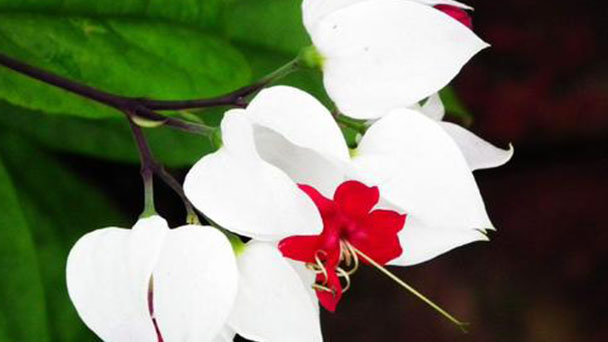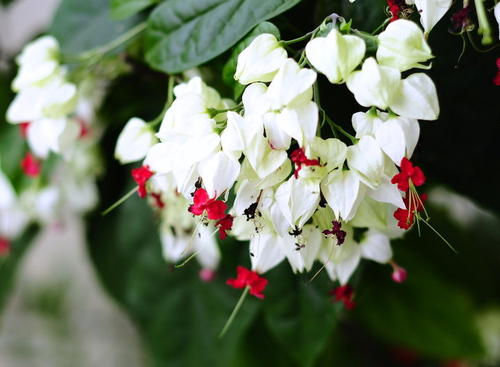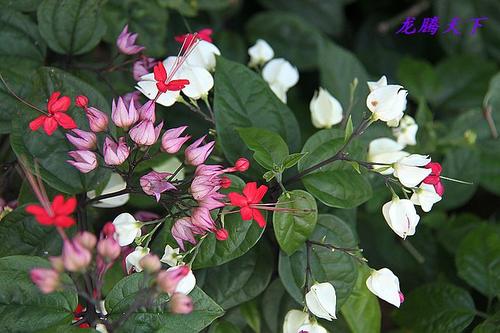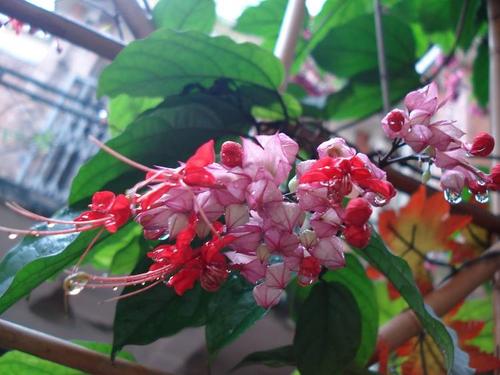How to Care for Bleeding Heart Vine - 2023 Guide
Written by Maggie
Jan 07 2023

When bleeding heart vine is actively growing, it needs to be regularly watered and fertilized. Use a rich, well-drained potting medium, and keep it moist but not soggy.
I believe a lot of people do not know, because it is not long in China's planting time. Now let's learn how to care for Bleeding heart vine.

Bleeding Heart Vine Overview
The tender, quick-growing tropical climbing vine known as bleeding heart resembles the herbaceous perennial bleeding heart in appearance but otherwise differs from it. It generates large clusters of eye-catching flowers. It has oval, glossy, dark-green leaves. It grows most successfully in the spring and blooms on new growth in the summer.
| Common Name | Bleeding heart vine, glory bower, bag flower |
| Botanical Name | Clerodendrum thomsoniae |
| Family | Lamiaceae |
| Plant Type | Evergreen, vine |
| Mature Size | Up to 5 feet tall and 15 feet tall. wide |
| Sun Exposure | Full, partial |
| Soil Type | Moist, well-drained |
| Soil pH | Acidic, neutral, alkaline |
| Bloom Time | Spring, summer |
| Flower Color | Red, pink, yellow, white, orage |
| Hardiness Zones | 9-12 (USDA) |
| Native Areas | Africa |
How to Care for Bleeding Heart Vine
Soil
The cultivation soil is fertile, loose and well-drained sandy loam, and the culture soil or the mixture of peat soil and coarse sand is used for pot cultivation. The commonly used soil formula is 4 parts of humic soil, 4 parts of garden soil and 2 parts of sandy soil.
Watering
It is sensitive to Bleeding heart vine, and needs sufficient water in growing periods. Stem and leaf growth period to keep the saline soil moist, but watering can not be excessive. Water is too large, resulting in only long tendrils and not flowering, even leaves yellow, fall, root rot and death. If the branch withered, stop watering, let it recover, germinating new leaves. In the summer high temperature season, it should be fully watered, appropriate shade. In winter, reduce watering, make it dormant, in order to ensure safety over the winter.
Sunlight
Sufficient sunshine in winter and shade in summer when it is too hot, otherwise the leaves will turn yellow. When the light is insufficient, it can cause Bleeding heart vine not blossom. Flower bud differentiation is not affected by photoperiod, but strong light can promote flower bud differentiation and development. It should not be placed in the dark for too long. At the temperature of 21℃ above, more than 24 hours, it will fall.
Fertilizing
Fertilizing should not be too much. Apply fertilizer once every half a month, add potassium phosphate fertilizer once or twice in flowering season, high potassium nitrate fertilizer in four seasons for "hui" 20-8-20, or apply rotten thin baking fertilizer water once every 7-10 days for 3 to 4 times. In winter, reduce watering and stop fertilizing. If yellowing phenomenon is found in the process of caring for Bleeding heart vine, the leaf can be gradually changed from yellow to green by applying topdressing (0.2% ferrous sulfate).

Trimming
When the cuttings or sowing seedlings grow to 15cm after pot planting, the branches are cut 10cm away from the mouth of the pot to promote the germination of strong new branches. During the growth period, strictly control the height of branches, pay attention to the top to pick the heart, in order to branch neatly, the future flowering densely. In half a month after the heart is picked, the application of Bijiu or Xiaozhuang to control the height of the plant, to achieve plant short, leafy, more flowers.
Repotting
12 ~ 15cm pots are commonly used for Bleeding Heart Vine. Each pot can be planted with 3 plants.Generally every 1 ~ 2 years for a replacement, replacement time in early spring or after the flower. When replacing the pot, first use broken tiles to pad the drainage hole, and then put a small amount of bone powder as base fertilizer, and then load the new culture soil, plant the plant, leaving 2 ~ 3 cm along the mouth, so as to fertilize and water. Change the pot after pouring permeable, put the shade of slow seedlings, slow seedlings moved to the sunny place after maintenance. More about Bleeding Heart Vine Propagation.
Pests and Diseases
In the beginning, it is just a few brown spots, but if not treated in time, it will give rise to large black spots and yellow leaves will die. So once found sick, we should immediately use chlorothalonil 800 times liquid, foliar spray, once every 7 ~ 8 days, 2 ~ 3 consecutive times, and it can be basically cured.
The main pests are scale insects, whitefly, etc., and can be sprayed with 40% oxidized dimethoate solution 1000 to 1500 times. Leaves can not stretch normally caused by alkaline soil, leaves lose green and yellow, and can be irrigated with 0.2% ferrous sulfate solution. For Mosaic disease and mycosis, it is necessary to remove the diseased leaves in time, strengthen ventilation, and keep the leaves dry, which can control the disease.

Types of Bleeding Heart Vine
Glory bower or bag flower plants come in more than 400 different varieties. Clerodendrum thomsoniae is named in honor of the 19th century head of the Thomas Thompson and the Calcutta Botanical Garden.
- Red Clerodendrum, Flaming Glorybower (Clerodendrum splendens): Evergreen vine; grows to 30 feet; large clusters of brilliant red flowers bloom profusely during winter
- Clerodendrum Vine (Clerodendrum x Speciosum): Evergreen shrubby vine; hybrid between Clerodendrum splendens and Clerodendrum thomsoniae; grows to 30 feet; blooms in winter and spring; features bicolored flowers with a dull pink or red calyx surrounding a short tube in deep crimson shaded with violet
- Shooting Star (Clerodendrum quadriloculare): Evergreen shrub; grows to 15 feet tall; clusters of fragrant pink flowers in fall and spring enhance the deep purple of the leaf undersides
- Harlequin Glorybower (Clerodendrum trichotomum): Deciduous shrub; grows about 15 feet tall and can be trained into a tree form; has fragrant blossoms with a white tube and fleshy red calyx; produces turquoise-colored fruit
Propagating Bleeding Heart Vine
Hard pruning keeps bleeding heart vine full, bushy, and the right size, which is beneficial. The use of semi-ripe stem cuttings in the early spring is another option for propagation. Bleeding heart vine can best be propagated by stem cuttings and grown by seed; here's how:
To propagate via stem cutting:
- Pruning shears that have been thoroughly cleaned, moistened potting soil or sand, a potting container, and possibly a transparent jar of water are all necessary.
- Using a straight knife, trim a 3- to 4-inch semi-ripe stem cutting that is located just below a leaf node. Only the top three leaves should be kept.
- The cut end should be submerged in water or planted in a pot with moistened soil. Put it on a heated surface, such as a heating pad, or a window sill with sunlight.
- For the plant in water: Replace the water in the jar as it evaporates every few days. In about two weeks, roots ought to start to show. Replant it in moist soil once you notice roots and keep it near a window that gets plenty of sunlight.
- Daily misting of the plant is advised for the planted cutting. Maintain moisture in the soil. In four to six weeks, roots should begin to show. You'll be able to tell if new growth starts to appear or if you gently tug on the stem and feel tension. Pull gently; otherwise, you risk damaging the newly planted roots.
How to Grow Bleeding Heart Vine from Seed
Green fruits that have been pollinated by flowers ripen into red and then black as they get older. Each fruit contains four black seeds that can be used for seed propagation. In the spring, when the temperature ranges from 55 to 64 degrees Fahrenheit, you can also plant seeds. Germination is a slow process that typically takes six to eight weeks, though under ideal circumstances it could start in just 20 days.
In order to break through the tough outer layer and increase the seed's chance of sprouting, nick it. Then soak it for a day. With your finger, lightly press the seed into the peat moss, vermiculite, or sand mixture. Soil should just barely (thinly) cover the seed. Put it in a location with plenty of sunshine and light. Utilize bottom heating to keep the plant warm, and keep the soil moist but not soggy. When the seedlings are big enough to handle (at least an inch tall) and have two sets of true leaves, transplant them into individual pots.
Overwintering
Move your glory bower indoors to grow as a houseplant if you live in an area with icy winters.
In its natural environment, the vine experiences a winter dormant phase and will inevitably die back as the temperature drops. From mid-November to mid-February, keep the plant in a cool location away from direct sunlight. Water only when the soil is dry; refrain from watering before new growth appears. Expect some leaf loss on the vine. Trim the vine back to 12 inches at the conclusion of the winter. Put the plant in a window that gets plenty of light, water it consistently, and fertilize to encourage growth. Repeat every year.
Common Pests and Plant Diseases
A fungus called botrytis blight can harm bleeding heart vines. By placing the vine in an area with good air circulation and using a fan or window breeze to provide ventilation, you can prevent fungal infection. Use sterile potting soil whenever you choose to propagate this vine from cuttings to prevent the development of fungal spores.
Mealybugs and spider mites will ravage a bleeding heart vine if given the chance, despite the fact that bleeding heart vine has few pests. On stems and leaves, mealybugs leave behind white tufts. Silk webbing on plants is a sign of spider mites. To get rid of both, either use a natural insecticide like organic Neem oil, or wash the plant in soapy water. Until the insects are gone, reapply the spray every seven to ten days.
Glasshouse whiteflies are an annoyance when grown indoors. Keep your plant well-watered, fertilized, in well-drained soil, and give it enough sun to have the best chance of survival against any pests. White oil (mineral oil) aids in the eradication of whitefly infestations.
How to Get Bleeding Heart Vine to Bloom
The bleeding heart vine's flowers are stunning. They usually sprout thin, wiry stalks in the spring, summer, or first part of the fall. Typically, they form terminal clusters of 8 to 20 flowers, each measuring 1/2 inch in diameter. The common name "bag flower" alludes to the shape of the white calyxes, which hold a red surprise inside as the inner red corollas emerge. The vines will draw butterflies outside because they are a rich source of nectar. The delicate panicles have a mild scent that is not overpowering. The flowers will yield fruits if they are pollinated.
Regularly feed every six weeks to ensure blooming. To promote flowering, apply calcium-enriched fertilizer or give the plant organic calcium supplements. After the first blooms slow down, trim the stems to within an inch of the ground to possibly force a second bloom. This will encourage more blooms. If you prune after the first bloom period, you don't need to deadhead.
As autumn draws near, the number of bleeding heart vine flowers in bloom decreases. If the climbing plant doesn't get enough light each day, it might not bloom. When bleeding heart vines are just barely pot-bound, they flower at their best.
Common Problems With Bleeding Heart Vine
Clerodendrum plants typically don't care too much about their soil; as long as they receive fertilizer on a regular basis, they will prosper.
Discoloration on Leaves
A plant may get scorching or discolored patches on its leaves if it receives too much sunlight or not enough water. Alternatively, give the plant more water or move it into some shade.
Webbing Or White Patches on Leaves
A spider mite or mealybug infestation may be indicated by silky webbing or white patches on leaves or stems. If humidity levels are too low, these plants are vulnerable to spider mites. Applying neem oil or insecticidal soap on a weekly basis will drive the insects away. The plant needs to be adequately moist every day, so spray or mist it with water.
Yellowing Leaves
A plant that has yellowing leaves may be receiving too much or too little water. Your plant probably needs more water if the temperature has been particularly high. Chlorosis is most likely to blame if the leaf develops yellow spots or begins to yellow all over.
Chlorosis is brought on by a lack of chlorophyll, which can be brought on by poor drainage, harmed roots, compacted roots, high alkalinity, and nutrient deficiencies in the plant. It may be possible to determine what nutrient the plant is lacking based on which leaves develop this condition first. If the younger or terminal leaves are the first to turn yellow, add iron (blood meal) as a supplement. If the older, inner leaves are the first to turn yellow, give manganese and zinc (bone meal).
FAQs
Does Bleeding Heart Vine Need a Trellis Or Support to Grow?
If you want to train this climber to extend to its full 15 feet in length, you can train it to climb a trellis, fence, or pergola. You could keep it pruned to remain a shrub or mound, though. In hanging baskets, the vines do well and will gracefully drape over the sides.
Are Bleeding Heart Vines Invasive?
Clerodendrum vines are well-behaved, non-aggressive plants that you can train to twine around a trellis despite their quick growth. It is not invasive.
What's the Difference Between Bleeding Heart Plant and Bleeding Heart Vine?
This plant (Clerodendrum thomsoniae) is commonly confused or mistakenly identified as a bleeding heart plant. This plant belongs to the mint family and is unrelated to the common bleeding heart (Lamprocapnos spectabilis), which is a member of the poppy family. Both plants resemble droplets that are emanating from calyxes with heart shapes.
Latest Updated
- Benefits of Bugleweed - 7 Science-backed Health Benefits
- Bugleweed Dangers & Side Effects - Is It Poisonous?
- How to Plant Evergreen Trees - What You Should Know
- When to Plant Evergreens - Grow Guide for Evergreen Trees
- 12 Wonderful Evergreen Shrubs for Your Garden
- 12 Popular Evergreen Plants with Pictures for Beginners
- When And How To Prune A Lilac Bush Like a Pro
- How to Grow & Care for Lilac Vine (Hardenbergia Violacea)
- Japanese Lilac Tree (Syringa Reticulata) Care & Propagation Guide
- Shumard Oak Pros and Cons - What to Know
Popular Articles
- Winter maintenance of Antirrhinum Majus
- How to Grow Terminalia Mantaly Tree
- How to Grow and Care for Crossostephium Chinense
- How to grow Antirrhinum Majus in spring
- Peristeria Elata (Dove Orchid) Profile: Info & Care Guide
- Underwatered Snake Plant (Sansevieria Trifasciata) - Signs And How To Fix
- How to Care for Brazilian Jasmine Plant (Mandevilla Sanderi)
- How to Grow & Care for Graptopetalum Purple Delight in Summer
- Rosa Chinensis (China Rose): Plant Growing & Care Tips
- How to Care for Baby Sun Rose (Aptenia Cordifolia)